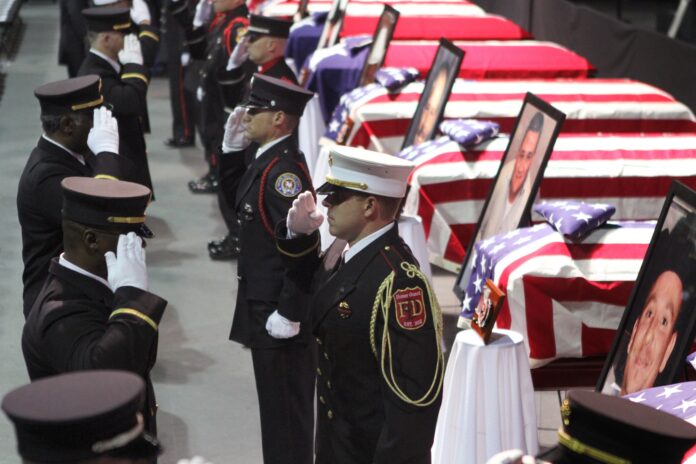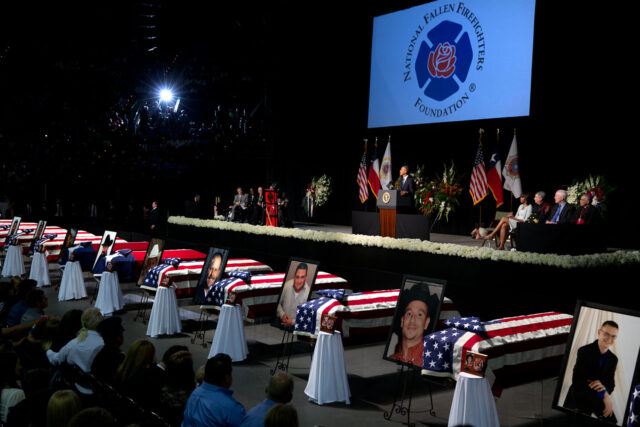
By Sydney Matthews | Staff Writer
Monday marked the 10th anniversary of the West Fertilizer Company explosion, a blast that killed 15 people — including 12 first responders — and destroyed the homes of many, impacting the lives of hundreds.
On Saturday morning, the West community gathered to honor the lives that were affected by the blast. There, the names of the fallen were read and the community paid their respects in front of the memorial of the event, serving as a reminder of the tragic day.
On April 17, 2013, the West Fertilizer Plant was holding 40 to 60 tons of ammonium nitrate and exploded with the force of 20,000 tons of TNT. The blast caused houses in the surrounding areas to be completely destroyed, along with a nursing home and a school.
The small town of West is located just 30 minutes down the road from Baylor’s campus. At the time of the explosion, it made national headlines and grabbed the attention of Americans across the country.

Amber Adamson, lecturer in the journalism, public relations and new media department, said she wanted to tell the stories of the first responders that answered the call that day.
“I recall seeing a photo on the local news the day after the explosion of a firefighter dressed in their class-A uniform standing among devastation and rubble, and they were standing at the railroad tracks that were located at the blast site looking over the blast site,” Adamson said. “The story with the photo was that the first responder was a part of a group who were standing guard to watch over the bodies of the fallen until they were able to be removed from the blast site. I really wanted to talk to that first responder and ask what he was thinking and experiencing while standing there.”
After seeing the initial photo, Adamson said she talked to over 40 first responders across Texas who attended the incident. She compiled the stories of the volunteer and career firefighters and first responders into a book she titled, “The Last Alarm.”
Adamson said a lot of the firefighters that responded to the call that day were volunteers. Since West is such a small town, the town relies on those volunteer firefighters in times of emergency. She said volunteers from all parts of Texas heard the call, got into their trucks and went without hesitation.
“This tragedy highlighted our need for one another in times of tragedy and what we can learn from it is that we need to be grateful for those who are willing to sacrifice,” Adamson said. “Some paid the ultimate price, others sacrificed in ways that will stay with them forever. We should be grateful for that and we should take the time to thank those who serve.”
Adamson also said she now uses her book to teach her journalism students the importance and responsibility that journalists have when telling a person’s story.
West junior Ashlyn Kapavik, a student in Adamson’s class, shared her experience of living through the explosion. She said she was only 12 years old at the time.
Kapavik said all of her family lived close to the fertilizer plant. With some family members living in “zone three,” known to be the area hit with the worst of the damage. She said as she was in the car going back home from church, she saw a building on fire, but was not sure what exact building it was.
“You could feel it suck you in and then it just exploded, and all of us fell to the ground,” Kapavik said. “There were pieces of debris falling everywhere.”
Kapavik said her and her family were all safe, but she said there were a lot of unknowns after the blast first hit. Homes from all over the area had to be rebuilt, including ones her family owned.
The years after the explosion were full of rebuilding for the community. Schools and other facilities in the area were destroyed.
“You don’t understand unless you live through it,” Kapavik said. “For a small town like West, it was crazy for us to hit national news and it was crazy the amount of support and outreach that we got from across the country, it was incredible.”
Kapavik said now the tragedy is a part of West. Every year the community gathers to honor the lives lost and appreciate those who responded to the event that day. The memorial serves as a reminder of the day and as a symbol of the town moving forward.




